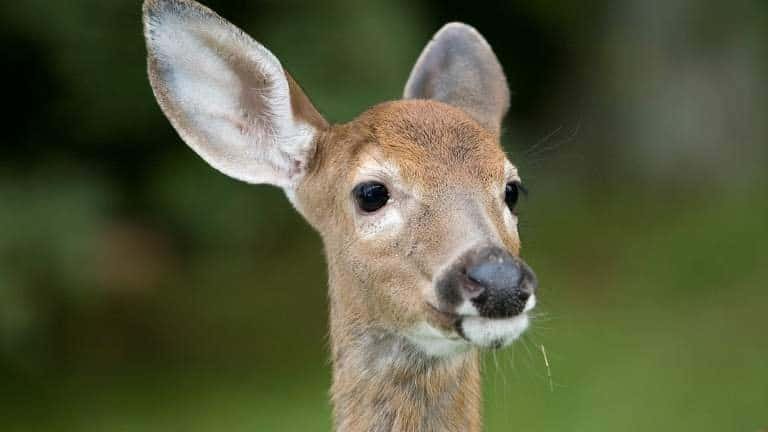While you might think that whiskers are a trait reserved for the likes of household pets and nocturnal predators, you’d be intrigued to learn that deer, those gentle grazers of the woodlands, also boast their own set of tactile hairs. Consider the last time you observed a deer up close—perhaps you didn’t give much thought to the purpose of those fine strands framing its face.
As you stand there in the tranquility of nature, you may find yourself curious about the ways these creatures use their whiskers to interact with their environment. Unbeknownst to many, deer whiskers are not just an aesthetic feature; they play a crucial role in the animals’ sensory navigation.
So, let yourself be guided into a deeper understanding of these enigmatic animals as we explore the silent language of deer whiskers and how it speaks volumes about their survival in the wild.
Do Deer Have Whiskers
Yes, deer do have whiskers! Deer rely on their whiskers to navigate their environment and identify threats. They use these sensitive hairs to enhance their sense of touch and smell. The chin whiskers, in particular, play a crucial role in helping deer sense the world. With over 297 million smell receptors, deer have an acute sense of smell that is augmented by their whiskers.
The whiskers are loaded with thousands of nerve cells, allowing them to detect the slightest changes in their surroundings. This ability is essential for finding food, especially in the wild where distinguishing between safe and poisonous plants is a matter of life and death. Deer can use their whiskers to feel around for food without having to see it directly, which is especially useful in the dark or in dense underbrush.
In addition to their role in finding food, whiskers also help deer gauge what is happening around their mouth and nose. This gives them a sensory advantage in detecting potential threats. Losing whiskers can seriously impair a deer’s ability to sense danger or find its herd, making them more vulnerable to predators.
Therefore, the chin whiskers of deer are much more than just facial hair. They are a key tool that allows these animals to sense their world and stay safe.
Functions of Deer Whiskers
Whiskers around the muzzle aren’t just for show; they’re packed with thousands of nerve cells, making them incredibly sensitive. For a whitetail deer, an acute sense of smell isn’t just nice to have—it’s essential for survival. With over 297 million smell receptors, their whiskers are like a supercharged olfactory device.
These tactile hairs help deer navigate their surroundings with precision. As they move through dense forests or graze in meadows, whiskers detect touch and vibrations, alerting deer to nearby obstacles or the approach of predators. It’s like having a personal radar that buzzes with information about the environment.
Moreover, when a deer needs to differentiate between safe and potentially poisonous food, those whiskers are invaluable. They can feel the texture and shape of plants, assisting in selecting the right greens for their diet. In essence, deer whiskers are versatile tools—part of an intricate system that ensures these animals can feed, escape danger, and thrive in their natural habitats.
Deer Whisker Sensitivity
Whiskers on a deer are packed with sensitive nerve cells that allow these animals to detect subtle changes in their environment, enhancing their ability to survive. These tactile hairs extend the sensory capabilities beyond what deers’ eyes can perceive, particularly in low-light conditions or when navigating through dense underbrush. The whiskers work like a radar, sensing objects, and obstacles, giving deer a clear advantage in the wild.
Imagine you’re walking through the woods, relying on touch rather than sight; that’s how deer use their whiskers. Each whisker is rooted deeply in a follicle surrounded by a rich network of nerve endings. These nerves are so finely tuned that deer can detect even the slightest touch or movement, such as a twig’s gentle brush or the rustle of leaves. This sensitivity is crucial for their foraging, allowing them to discern between edible and harmful plants with precision.
Furthermore, chin whiskers function as a delicate sensory system, guiding deer to food sources and away from potential risks. They can identify the animal a scent belongs to and the direction it went, safeguarding their territory and young. It’s a complex sensory tool that’s all rights reserved for survival in the unpredictable wild.
Whisker Variation Among Deer
Just as humans have unique fingerprints, variations in whisker pattern and length exist among different deer species, reflecting their adaptation to diverse habitats and lifestyles. You might find that the whiskers of a white-tailed deer, for instance, are perfectly tailored to navigating the dense forests and brush they often inhabit. With thousands of nerve cells packed into each whisker, they can detect the slightest changes in their environment, from the rustling of leaves to the approach of predators.
These nerve cells are so sensitive they can even identify the direction and source of a scent. This is crucial for deer when they need to stay upwind of predators or track down food. The chin whiskers, in particular, act like a sensory system, guiding them as they forage for food, ensuring they pick safe, nutritious plants over potentially harmful ones.
Every whisker is an integral part of a deer’s anatomy, as important to their survival as their keen sense of hearing or sharp eyesight. It’s fascinating to realize that such a small feature can have such a significant impact on the life of these graceful creatures.
As you observe deer in their natural habitat, consider the silent, yet essential role their whiskers play.
Impact of Whisker Loss
While exploring the vital role that whiskers play in a deer’s life, it’s equally important to consider the repercussions of their loss. If a deer loses its whiskers, you can imagine the challenges it would face. No longer would it have its usual fine-tuned navigation tools. Navigating through dense underbrush or darkness becomes a risky endeavor without the tactile feedback whiskers provide.
Without these sensitive hairs, deer are at a disadvantage when selecting food. They could easily mistake poisonous plants for safe ones, putting their health at risk. Their ability to sense the quality of their food is compromised, potentially leading to the consumption of contaminated sources that could be harmful.
The absence of whiskers also leaves deer more exposed to predators. These animals rely on their vibrissae to detect subtle changes in their environment, warning them of potential dangers. Losing this early detection system means they mightn’t recognize a threat until it’s too late.
Whisker loss affects a deer’s scent detection as well, which is crucial for their survival. Without it, finding food, avoiding predators, and even social interactions with other deer become more challenging. In short, whisker loss can drastically alter a deer’s ability to thrive in the wild.
Do All Deer Have Whiskers?
Every species of deer is equipped with whiskers, which serve as a critical sensory tool for their survival. These tactile hairs, or vibrissae, aren’t just for show; they’re a key part of how deer interact with the world. You’ll find them prominently displayed on the muzzle of each deer, regardless of the species. They function like a natural radar, helping deer to feel and gauge their surroundings with precision.
Feel those tiny twitches? That’s your deer using its whiskers to navigate through dense vegetation, avoiding potential dangers and seeking out food. The chin whiskers, in particular, are vital. They act as a sensory system for whitetail deer, allowing them to feed efficiently and stay alert to any threats lurking in the wild.
Imagine a deer without its whiskers; it’d be like losing a sense. Whiskers are so essential that their loss can make deer more vulnerable to predators. It also hampers their ability to distinguish between what’s safe to eat and what could be poisonous. So, yes, all deer have whiskers, and they play a substantial role in their survival, feeding, and sensory perception.
Conclusion
So, you’ve discovered that deer do indeed sport whiskers, much like your neighborhood pets. These tactile hairs are crucial for their survival, enhancing their senses and helping them navigate their habitat.
Whether it’s detecting breezes or brushing through underbrush, whiskers offer deer a silent but potent tool. All deer are whiskered, and losing them could hinder their delicate dance with nature.
Now you know, those whiskers are more than mere adornments; they’re a deer’s silent sentinels.

